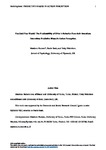You Said You Would! The Predictability of Other's Behavior From Their Intentions Determines Predictive Biases in Action Perception.
| dc.contributor.author | Hudson, Matthew | |
| dc.contributor.author | Bach, Patric | |
| dc.contributor.author | Nicholson, T | |
| dc.date.accessioned | 2017-06-28T11:19:05Z | |
| dc.date.available | 2017-06-28T11:19:05Z | |
| dc.date.issued | 2017-05-29 | |
| dc.identifier.issn | 0096-1523 | |
| dc.identifier.issn | 1939-1277 | |
| dc.identifier.uri | http://hdl.handle.net/10026.1/9560 | |
| dc.description.abstract |
The perception of an action is shifted farther along the observed trajectory if the observer has prior knowledge of the actor's intention. This intention-action prediction effect is explained by predictive perception models, wherein sensory input is interpreted in light of expectancies. This study altered the precision of the prediction by varying the predictability of the action from the intention, to increase/decrease the predictive perceptual bias. Participants heard an actor state an intention ("I'll take it"/"I'll leave it") before the actor reached or withdrew from an object, thus confirming or contradicting the intention. The intention was predictive of the action (75% congruency) for one group and counterpredictive (25%) for another. The action disappeared midmovement and participants estimated the disappearance position. The intention-action prediction effect was greater if the intention was predictive than if counterpredictive. However, participants needed to explicitly know the predictability rates (Experiments 1 and 3). No group differences emerged when both groups believed the intention was nonpredictive (Experiment 2a), nor when a nonpredictive intention was believed to be (counter)predictive (Experiment 2b). The perception of others behavior is determined by its predictability from their intentions, and the precision of our social predictions is adapted to individual differences in behavior. (PsycINFO Database Record | |
| dc.format.extent | 320-335 | |
| dc.format.medium | Print-Electronic | |
| dc.language | en | |
| dc.language.iso | en | |
| dc.publisher | American Psychological Association (APA) | |
| dc.subject | representational momentum | |
| dc.subject | action prediction | |
| dc.subject | predictive coding | |
| dc.subject | implicit theory of mind | |
| dc.subject | associative learning | |
| dc.title | You Said You Would! The Predictability of Other's Behavior From Their Intentions Determines Predictive Biases in Action Perception. | |
| dc.type | journal-article | |
| dc.type | Journal Article | |
| plymouth.author-url | https://www.ncbi.nlm.nih.gov/pubmed/28557497 | |
| plymouth.issue | 2 | |
| plymouth.volume | 44 | |
| plymouth.publication-status | Published online | |
| plymouth.journal | Journal of Experimental Psychology: Human Perception and Performance | |
| dc.identifier.doi | 10.1037/xhp0000451 | |
| plymouth.organisational-group | /Plymouth | |
| plymouth.organisational-group | /Plymouth/Faculty of Health | |
| plymouth.organisational-group | /Plymouth/Faculty of Health/School of Psychology | |
| plymouth.organisational-group | /Plymouth/REF 2021 Researchers by UoA | |
| plymouth.organisational-group | /Plymouth/REF 2021 Researchers by UoA/UoA04 Psychology, Psychiatry and Neuroscience | |
| plymouth.organisational-group | /Plymouth/Research Groups | |
| plymouth.organisational-group | /Plymouth/Research Groups/Centre for Brain, Cognition and Behaviour (CBCB) | |
| plymouth.organisational-group | /Plymouth/Research Groups/Centre for Brain, Cognition and Behaviour (CBCB)/Brain | |
| plymouth.organisational-group | /Plymouth/Users by role | |
| plymouth.organisational-group | /Plymouth/Users by role/Academics | |
| dc.publisher.place | United States | |
| dcterms.dateAccepted | 2017-04-24 | |
| dc.identifier.eissn | 1939-1277 | |
| dc.rights.embargoperiod | Not known | |
| rioxxterms.versionofrecord | 10.1037/xhp0000451 | |
| rioxxterms.licenseref.uri | http://www.rioxx.net/licenses/all-rights-reserved | |
| rioxxterms.licenseref.startdate | 2017-05-29 | |
| rioxxterms.type | Journal Article/Review | |
| plymouth.funder | One step ahead: Prediction of other people's behavior in healthy and autistic individuals.::ESRC |


